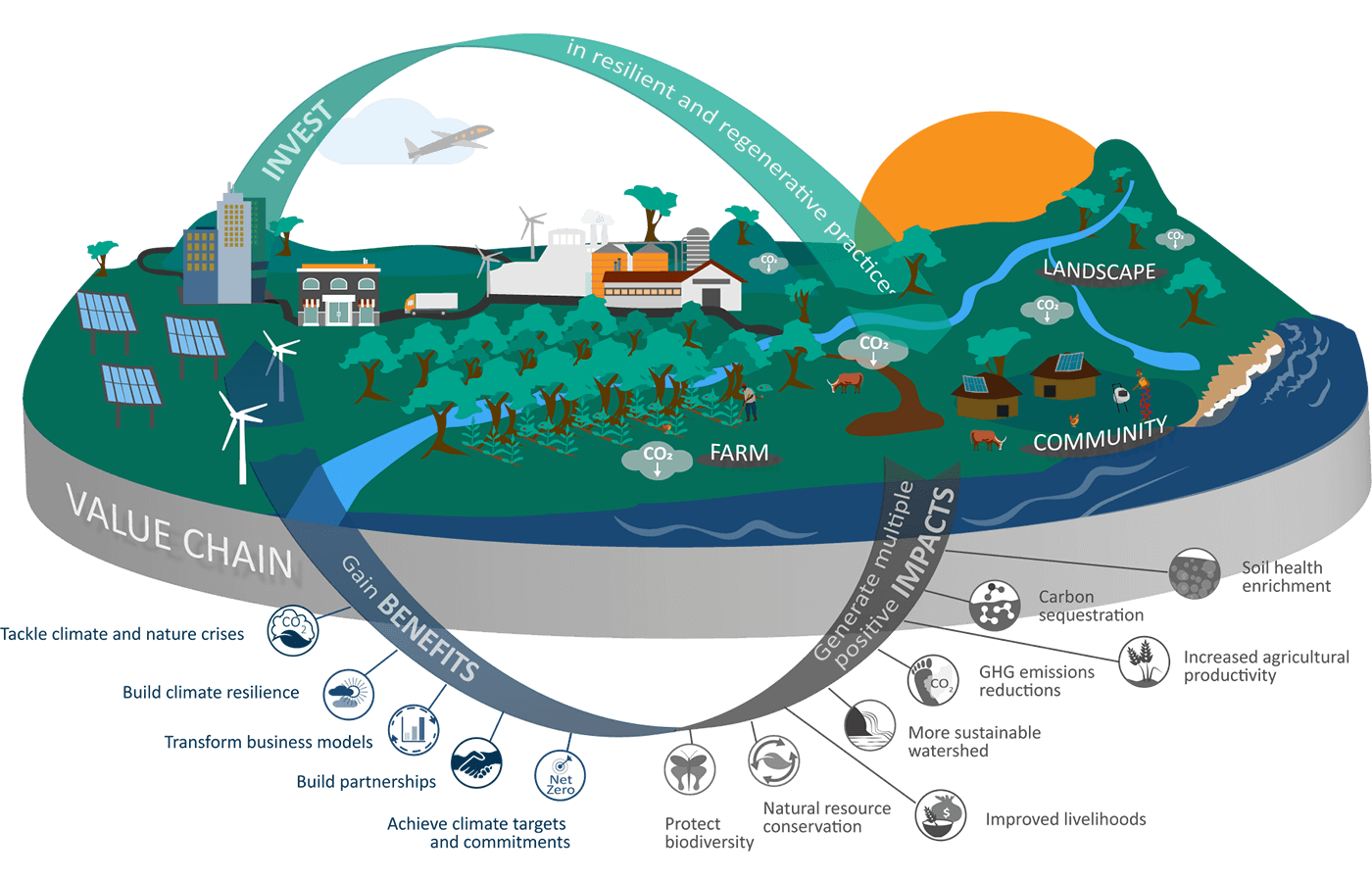What is insetting?
Insetting is a way for companies to harmonise their operations with the ecosystems they depend upon and transition to a more sustainable business model.

INSETTING PROJECTS are interventions along a company’s value chain that are designed to generate GHG emissions reductions and carbon storage, and at the same time create positive impacts for communities, landscapes and ecosystems.
INSETTING INTERVENTIONS are typically based on regenerative agriculture practices and agroforestry programmes both at farm level and with local communities. They re-establish natural carbon sinks through conservation and restoration of the surrounding landscapes including forests, wetlands, coastal and marine ecosystems. These interventions allow companies to achieve corporate sustainability goals, whilst building climate resilience and supply chain stability at the heart of their operations, future proofing their businesses, and improving the quality of raw materials.
WHAT IS INSETTING?

Why implement insetting?
“The future of climate action, and to a larger extent, economic growth, depends on ecosystem regeneration. Integrating these strategies into our core business models and along supply chains will benefit all involved.”
Tristan Lecomte, Co-Founder of the IPI
Tackling the climate emergency and reversing the loss of nature requires urgent action by all sectors of society with an integrated approach that is in line with science and has nature-based solutions at its core.
Companies need to accelerate climate action to achieve net-zero emissions by 2050 and transition to resilient and regenerative business models that can support them through climate, nature and health crises. Forward-thinking businesses understand the importance of investing in healthy ecosystems within and beyond their operations by protecting and valuing nature.
Insetting is a strategic mechanism used to scale effective nature-based solutions, enabling businesses to deliver against ambitious climate and sustainability goals and harmonise their operations with the ecosystems they depend upon.
Benefits of insetting

Multiple positive impacts
Businesses reduce the GHG emissions of their operations, increasing carbon sequestration by re-establishing natural carbon sinks, increasing soil health, restoring local water cycles and reversing the loss of forests and biodiversity. At the same time they build climate resilience, support the livelihoods of local producers and strengthen communities.

Integrated approach
All projects are developed within ecosystems connected to the organisation’s value chain, allowing for its vision, values, management system and programs to be incorporated throughout.

Transforming business models
Working closely with suppliers and implementing low-carbon and regenerative practices at the heart of a company’s value chain helps to use the land sustainably, building a more resilient business model.

Achieving targets
Insetting projects deliver wide ranging positive impacts which help companies achieve their sustainability targets and deliver against commitments made on climate, nature and communities.

Climate adaptation
As well as reducing emissions, insetting can also build climate resilience within a company’s supply chain and help restore vital ecosystems on which the suppliers depend. By creating synergies between climate change mitigation and adaptation in agriculture, insetting can also generate incentives and funding for climate change adaptation while enhancing farmers’ livelihoods.

Competitive advantage
Improved management of agricultural lands and natural resources leads to greater productivity and a more stable supply of raw materials, making companies’ value chains more resilient over the long-term.

Partnerships
Companies’ relationships with other value chain actors are transformed beyond simply a financial transaction. Working in partnership with suppliers builds trust, bringing a greater transparency to supply-chain activities, and helping to identify emissions reductions opportunities that create shared value for everyone.

Scaling nature-based solutions
Insetting enables businesses to integrate their investment in nature into their sustainability strategies and goals. Improved agricultural practices, agroforestry, restoration and conservation allow companies to effectively address both the climate and nature crises at once.
Insetting and nature-based solutions
We cannot address our planet’s climate emergency without reversing the loss of nature. Evidence shows that strong, and healthy ecosystems can help to fight climate change as well as build resilience and help us adapt to climate impacts. In order to keep the global temperature rise below 1.5°C, we need to decarbonise our economy as well as promote and support strong “nature-based solutions” such as natural systems agriculture and ecosystem restoration approaches. In the next 10-15 years, these nature-based solutions can provide more than a third of the emissions reductions required to meet the 1.5°C goal.
Insetting helps businesses to transition to resilient and regenerative business models through nature-based solutions
Business as usual
Typical nature-based insetting interventions




Insetting projects help to protect, value and reverse the loss of nature, create regenerative processes in companies’ operations and demonstrate the business case for investing in nature. This allows businesses to integrate their investment in nature into their sustainability strategies and goals, providing a way to scale nature-based solutions across industries, sectors and geographies.
Insetting enables companies to take a holistic and integrated approach to climate action through a connection to the communities and landscapes they source from. This addresses complex issues such as the drivers of deforestation, through implementing long-term sustainable agriculture and forestry practices, and builds much more sustainable land use models.
FAQs ON INSETTING
There is no doubt that the term insetting derives from carbon offsetting and the idea of creating projects that are generating tradable carbon credits within a company’s value chain. However, for members of the IPI, the concept of (carbon) insetting goes beyond interventions that are designed to generate carbon gains. The IPI advocates for a wider understanding of the term insetting, that allows for other drivers behind an insetting intervention, such as the improvement of livelihoods of communities a company is sourcing from or the preservation of biodiversity, without these projects generating carbon credits.
Insetting currently does not require verification or certification against agreed global standards. Nevertheless, many insetting companies choose to work with an independent verifier or auditor to certify their results according to existing standards, as verification gives an insetting project more credibility. These standards are chosen by the company depending on the main results and impacts the intervention focuses on. Resources used are the standards from Gold Standard, Verra, Rainforest Alliance, Plan Vivo, the IPI’s Insetting Program Standard and others.
Science Based Targets initiative: “There is no international standard or consistent definition to describe insetting projects nor an agreed methodology to account for their GHG emission reductions. Further work needs to be done to standardize the definition of insetting projects and to develop a clear accounting methodology. For these reasons, the SBTi will be open to consider these projects as a way to achieve SBTs under certain circumstances. Insetting projects could potentially count as long as the emissions they address are within the Scope 3 emissions boundary of the company and as long as there is no double counting (i.e. the impact of the project it is not being counted by another company – other than the one developing the insetting project and the company taking into account the insetting reductions for Scope 3 purposes).”
There are emerging resources such as the Value Change programme led by Gold Standard and the Carbon Removals and Land Sector Initiative led by WRI that will provide further guidance on how to account for impacts of insetting interventions.
Land use changes and the degradation of agricultural soils and natural ecosystems are significant contributors to our global climate crisis. As such, they provide one of our greatest tools to address both climate mitigation and adaptation. Many of the interventions addressed through insetting are nature-based solutions, where ecosystems are either restored or conserved. Community-based and community-led solutions are often also nature-based solutions. For example, the provision of water filtration and clean cookstoves can prevent deforestation and conserve ecosystems. Insetting is a young concept and the term is being used in different ways. However, the past few years have shown that insetting in practice is mainly focusing on nature-based solutions. The IPI supports this movement and promotes insetting as a strategic mechanism to scale investments by companies into nature.
Carbon offsetting is a mechanism for companies to purchase carbon credits from projects that create a reduction in emissions of carbon dioxide or greenhouse gases (GHG) in order to compensate, or offset, their unavoidable emissions. Purchasing the credits helps to finance and support projects with a positive impact that contribute to the achievement of the Sustainable Development Goals, improve the livelihoods of local communities, and create social, economic and environmental benefits on a global scale.
As the name suggests, the term insetting derives from the concept of carbon offsetting. Carbon offsetting usually balances the positive impact of a GHG reduction activity outside of a company’s direct or indirect operations. Insetting on the other hand, refers specifically to GHG reductions or carbon sequestration interventions that are directly related to a company’s value chain, either by geography, production, or commodity. Instead of financing an existing project elsewhere through offsetting, insetting projects are developed with partners along the value chain and are tailored for the operations and impacts of the company.
Insetting is often used by companies in conjunction with offsetting, with the ambition to move from offsetting to insetting as a way to meet climate targets and to transition to more sustainable business models. Increasingly, companies are using insetting as a credible and valuable solution to align their activities with global climate targets of 1.5 degrees warming, deforestation-free commodities, net-zero or net-positive emissions, and the Sustainable Development Goals.
